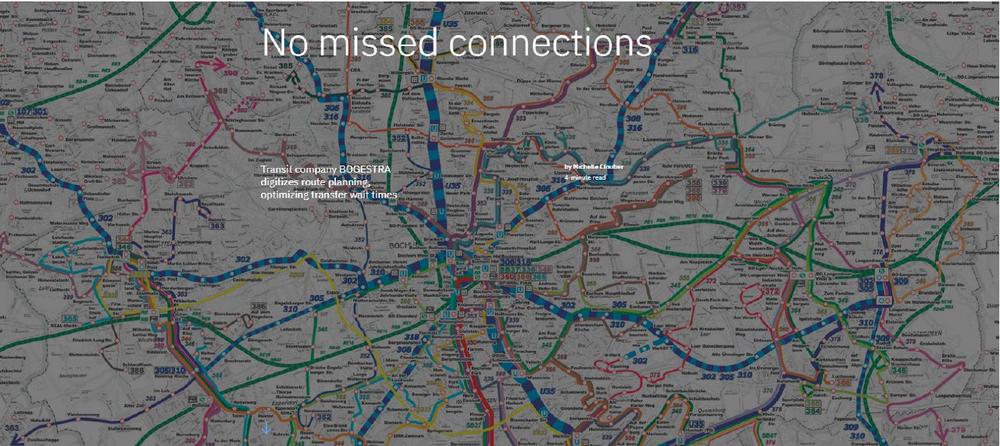
Nothing is more frustrating for public transportation passengers than missing a connection to the next tram, train or bus. Tempers flare, especially when the schedule says that they would have made the connection if their bus hadn’t gotten stuck in traffic.
Transportation planners know that customer satisfaction is dependent on shortening passenger wait times as much as possible, especially for transfers between modes, for example, from a bus to a tram or train. But typical spreadsheet-based planning methods are static, limiting the ability to dynamically plan and respond to actual transportation situations such as increased rush hour traffic or slow-downs due to construction.
BOGESTRA AG operates the public transportation system in the central Ruhr region of Germany. Its network includes 83 bus and 12 train lines that serve almost 150 million passengers each year. BOGESTRA wants to provide exceptional service to each one.
Until 2018, BOGESTRA used Microsoft Excel spreadsheets for route planning timetable creation. BOGESTRA not only planned individual bus and train routes, but also coordinated the transfers between those lines, for example, working to ensure that someone taking a bus would not miss, or wait too long for, the tram or train that would take them to their final destination.
The planning process was detailed, manual and time-consuming for the team of five planners at BOGESTRA. And, before making changes to its own timetable, the company needed to coordinate with other, adjacent transportation operators to optimize connections with their systems. This required sending the spreadsheet by email for multiple, iterative reviews and follow-up meetings by telephone.
In an age of instant communication and digitization, BOGESTRA wanted to find an innovative, digital solution to optimize its planning processes. Improving service quality, especially line transfers, for its customers was the paramount driver for the change. BOGESTRA also anticipated improving internal efficiencies, allowing its planning staff to focus on other critical tasks.
BOGESTRA turned to IBM Business Partner Bechtle Logistik & Service GmbH, an IT services provider with whom it already had a relationship, to explore possible digital planning solutions. Bechtle in turn introduced the client to SPOO Group GmbH, which had developed a transportation planning solutionExternal Link for local transit providers.
Bechtle, which provided overall project management, recommended that BOGESTRA deploy the SPOO Group solution on IBM Cloud®. IBM Cloud provides the flexibility and scalability that BOGESTRA needed at a lower price than other cloud providers. SPOO Group developers also appreciated the ease of development and deployment using IBM Cloud Kubernetes Service as well as the built-in security features of IBM Cloud.
All participants in the project worked closely together to help ensure that the final platform met BOGESTRA’s needs and expectations. “We started with workshops to record the customer requirements in detail,” says Florian Schindler, Chief Product Officer (CPO) at SPOO Group. “We involved the customer very deeply in the requirements phase and in product development to ensure that the technology would meet their business and market needs.”
SPOO Group standardized the solution so that, after importing and defining the relevant master data into chosen IBM Cloud database technology, BOGESTRA could quickly begin using the platform for planning purposes. It provides an intuitive user interface that allows planners to easily visualize existing routes and connections, including wait times for transfers.
The platform integrates with Google Maps and includes real-time simulation capabilities to measure passenger walking and waiting times. The solution also accounts for rush hours and uses a traffic light alert system to help planners see current wait times and optimize routes to eliminate long waits and improve service. Real-time simulations help planners refine and improve routes. Finally, it includes line-sharing capabilities with neighboring transit companies to facilitate coordination.
SPOO Group GmbH
Heinrich Hertz Strasse 2
79211 Denzlingen
Telefon: +49 (7666) 913336-0
https://piles.cards
Vertrieb
Telefon: +49 (7666) 913336-0
E-Mail: Heinz.Boelling@SPOO-Group.com
![]()

